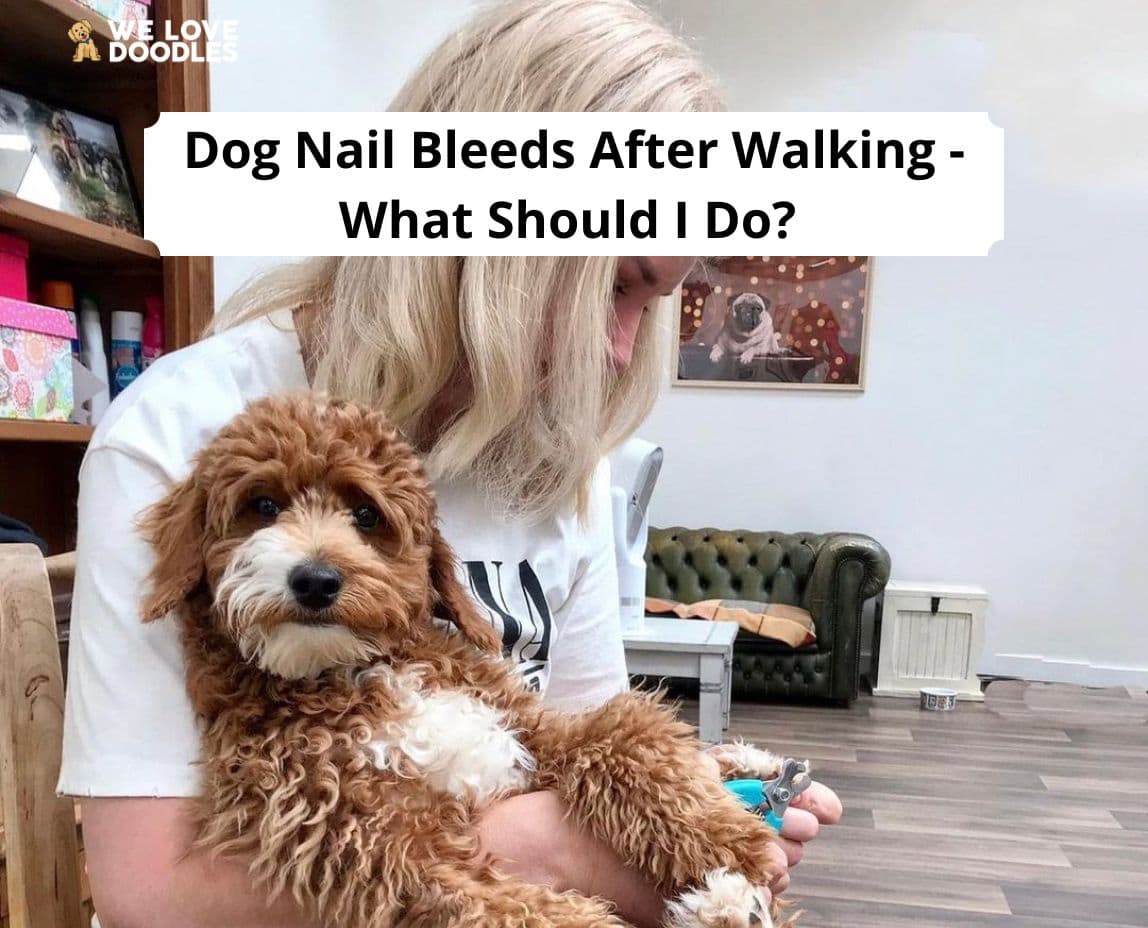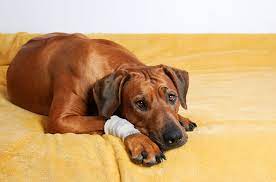There are many reasons why dogs use their nails. The most important function of dog nails is to provide traction and stability when they stand, walk, or run. Furthermore, they assist in activities such as playing, digging, and grasping.
Feeding your dog a balanced and nutritious diet, as well as keeping his nails at an appropriate length, can prevent most problems from arising, but an injury, disease, or infection can still occur.
The quality of life of your dog can be significantly impacted by serious nail problems. Due to the fact that dogs walk, their nails are usually more painful than those of humans. Your dog’s pain and discomfort can be reduced if he receives early detection, which makes treatment easier. In this article, veterinarian Amanda Takiguchi will explain why your dog’s nails bleed after walking and what you can do about it.
Other articles you would like: Why Does My Dog Scratch The Floor?
What Can Cause A Dog’s Nail To Bleed?
A dog’s nails can bleed for a variety of reasons when walking. An injury to the nails can occur if your dog encounters rough terrain, stumbles, or has nail problems. After a walk, bleeding nails in dogs are caused by various things.
Cut The Quick
At the tips of each paw, there are veins and nerves which provide nourishment for the nails to grow and hold on. A thick layer of hard material known as keratin covers your dog’s external nails, but when your dog walks on hard surfaces, the keratin erodes. Your puppy’s claw consists of three parts: bone, quick, and nail. In case your dog’s nails grow excessively, this is undoubtedly helpful.
Cracked
The pads of a dog’s paws are usually rough. Movements such as turning in haste, stopping abruptly, and sprinting off can be facilitated by this. A pair of paw pads that is dried out and cracked becomes vulnerable to injury, collects debris inside the cracks, and is in pretty poor condition.
In the event of slight trauma, bleeding becomes easy and can occur. You should provide your dog’s paws with good care to prevent this. Protect them from harsh weather conditions by moisturizing them with footpad moisturizing creams.
Thorns Or Rocks
In dogs, thorns and other splinters often get stuck in their paws since they are active animals that enjoy playing outside. You will probably find that your dog limps or hesitates to take a step with the injured foot if this occurs. Your dog may be in pain, but the treatment is usually straightforward. Your dog should be able to recover fully after meticulously removing the thorn and thoroughly cleaning it.
Scrapes
It is very easy for dogs to run across rough or painful surfaces while walking, and their nails can be scraped or torn off as well. The nail may bleed as a result. It is also possible for them to scrape their nails on sidewalks or roads and tear them down to the quick, which can also be painful and cause bleeding.
How To Treat A Bleeding Nail
If you find that your dog’s nails are bleeding after walking, you should treat the injury immediately. Here are some things you can do to help control bleeding and pain.
Clean the wound
The bleeding usually stops after a few minutes on a dog’s toenail. However, that does not mean you should not take action and clean your dog’s wound. Wipe the wound with a clean cloth dipped in a warm soapy solution. As a result, not only will the wound be cleared of blood, but bacteria will be prevented from getting into it, thus minimizing the risk of infection.
Medical intervention is necessary when infections spread rapidly throughout the body. Additionally, it’s important to keep an eye on your dog to prevent him from licking and scratching at its toenails, which can lead to infection. It may be necessary to use an Elizabethan collar to limit your dog’s access to the bloody toenail if he is very insistent on licking it.
Apply Pressure with a Clean Cloth
Using some force on the injured part of the dog’s nail is similar to how you would stop a nosebleed. Clean the affected area with a paper towel for a few minutes. The blood should clot within a couple of minutes in most cases.
The importance of using a clean cloth cannot be overstated since anything that’s dirty may spread bacteria and germs to the dog. Dog nails differ from human nails in their anatomy. It is possible for your dog’s nails to bleed while being trimmed because they contain blood vessels.
Apply Styptic Powder
Every dog owner should have styptic powder on hand as a first aid item. Blood vessels exposed to this powder will be sealed off once they are contracted, thereby stopping bleeding. For animals, you can buy styptic powders designed specifically for their needs. There are no complicated instructions. Provide lots of praise and treats to your dog to ensure he is calm. Make sure the dog’s feet are clean and free of dirt and debris. Styptic powder should be gently rubbed into the dog’s nails, letting the powder soak into the nails until the bleeding stops.
Alternatively, you can use cornstarch instead of styptic powder if you don’t have any at home. Due to its drying properties, corn starch speeds up clotting. Corn starch can be applied to the dog’s nail by just dipping it in it.
Apply Super Glue
Even though it might sound strange at first, superglue is actually not that unusual. In hospitals, cyanoacrylate is regularly used as a dynamic fixer in a super paste. A super glue can be used to fix a bleeding nail on your dog.
Using it on your dog is safe since even oral entry points are sealed with a stick. Ensure that none of the glue gets ingested by your dog before it dries. Closing the wound prevents the nail from draining and evading further wounds on a dog.
See A Vet
It is sometimes necessary to seek veterinary care. Nail that is ripped or deep cut but still attached may need to be removed surgically, or it may require stitches. In most cases, you can treat bleeding through the quick of the nail at home. It may be necessary to remove damaged parts of the nails during the first visit to the vet. It may be necessary to sedate the dog so that the wound can be appropriately treated without causing pain or stress to the dog.
It is imperative to stop bleeding as soon as possible. It will then be necessary to disinfect the area. It will be necessary to remove the portions of the nail that are partially hanging.
Additionally, pain medication and antibiotics can be prescribed to prevent infections and to protect the area after removing a large part of the nail, and bandages might be used. If follow-up treatment is necessary, your veterinarian will let you know.
It is very important to monitor your dog’s foot constantly to make sure the nail is healing, that there are no further inflammations or infections, and that regrowth is occurring. Taking your dog to the vet for a recheck is a good idea if the nail does not grow back or does so irregularly.
How To Prevent Dog Nail Injuries
You may find it difficult to trim your dog’s toenails. It is important to clean and compress the wounds as soon as possible to reduce pain and reduce the likelihood of an infection developing. The use of styptic pencils and powders is another effective way of minimizing bleeding; both seals injured blood vessels and speed up the healing process.
In order to avoid cutting too close to the nail bed, also known as the quick, when trimming your dog’s toenails, keep the clippers away from the nail bed. When your dog goes outside for walks, nicks to the skin can open the door to an infection if a vein in the nail bed has been accidentally cut, causing excessive bleeding. Make sure you look at the free edge of your dog’s nails closely before cutting them, so you know where the nail plate begins and ends. Nails should only be cut along their free edges.
Other articles you would like:
Still curious to learn how to treat your dog’s bleeding nails? Check out the video below:
Garrett loves animals and is a huge advocate for all Doodle dog breeds. He owns his own Goldendoodle named Kona. In addition, he volunteers at the Humane Society of Silicon Valley, where he fosters dogs and helps animals. Garrett enjoys writing about Doodles and believes that dogs can teach humans more about how to live than humans can teach a dog.
Why Trust We Love Doodles?
At We Love Doodles, we’re a team of writers, veterinarians, and puppy trainers that love dogs. Our team of qualified experts researches and provides reliable information on a wide range of dog topics. Our reviews are based on customer feedback, hands-on testing, and in-depth analysis. We are fully transparent and honest to our community of dog owners and future owners.










